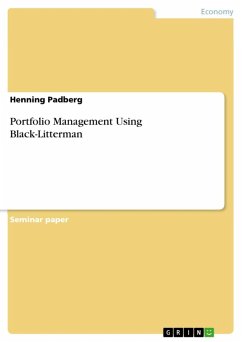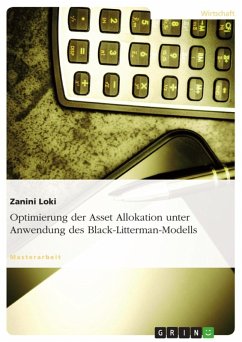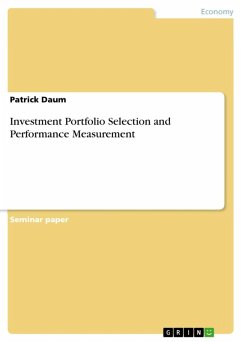Seminar paper from the year 2007 in the subject Business economics - Banking, Stock Exchanges, Insurance, Accounting, grade: 1,3, University of Münster (Finance Center Münster), course: Betriebliche Finanzierung (Finance Seminar), language: English, abstract: The Black-Litterman optimization model is based on the idea of efficient markets and the capital asset pricing model (CAPM). The BL model enhances standard mean-variance optimization by implementing market views into the optimization process (probability theory). Investors obtain sophisticated and reasonable asset allocations. Portfolio management usually comprises asset allocation decisions with the goal of creating diversified portfolios. Managers can consult quantitative models to support their decision-making process. Fischer Black and Robert Litterman (1992) developed the Black-Litterman (BL) optimization model. It is based on the idea of efficient markets, the capital asset pricing model of Sharpe (1964) and Lintner (1965), as well as the established mean-variance optimization (MVO) developed by Markowitz (1952), and conditional probability theory dating back to Bayes (1763). Starting point of the BL model is the assumption that equilibrium markets and market cap. weights provide the investor with Implied Returns. The BL model uses a mixed estimation technique to incorporate investors' Views into return forecasts. It is possible to implement relative and absolute opinions regarding expected returns of assets with different levels of confidence. These Views enable an adjustment of equilibrium Implied Returns, which forms a new expectation of BL Revised Implied Returns. As a result of optimization with BL input data, the investor gets new optimal portfolio weights. The motivation of Black and Litterman (1992) to develop a new portfolio optimization tool was a lack of acceptance of the Markowitz algorithm within professional asset managers. There aim was to shape a model which can overcome the weaknesses of MVO and which combines a quantitative and qualitative approach. Consequently, the BL model tackles the weakest point of MVO, its sensitivity to the return forecasts and allows taking active Views. This paper is structured in the following sections: First, it shows the basic principles on which the BL model is founded. Then, it illustrates the model by means of its assumptions, the general approach, and the math involved. Finally, it evaluates the model in a critical review, provides an overview of applicable extensions, and addresses the issues of practicability and behavioral finance.
Dieser Download kann aus rechtlichen Gründen nur mit Rechnungsadresse in A, B, BG, CY, CZ, D, DK, EW, E, FIN, F, GR, HR, H, IRL, I, LT, L, LR, M, NL, PL, P, R, S, SLO, SK ausgeliefert werden.









